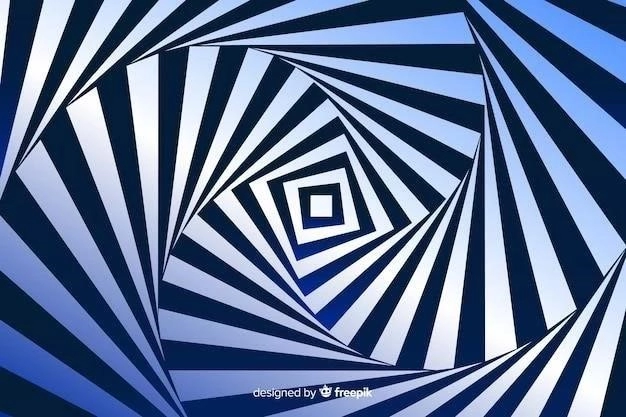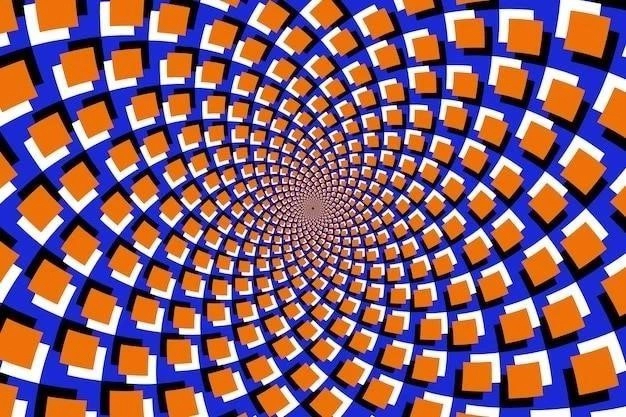Our visual perception is a complex process that involves both our eyes and our brains. Light enters the eye and is focused on the retina, where it is converted into electrical signals that are sent to the brain. The brain then interprets these signals to create a visual representation of the world around us. However, sometimes our brains can be tricked by certain visual stimuli, leading us to perceive things that are not actually there or that are different from how they appear. These tricks of the eye and brain are known as optical illusions.
Types of Optical Illusions
Optical illusions can be broadly categorized into three main types:
-
Literal Illusions
Literal illusions occur when the image we perceive differs from the actual object or scene being viewed. This happens when the brain makes assumptions about the visual information it receives, based on our past experiences and expectations. For example, a straight stick may appear bent when partially submerged in water due to the refraction of light. Our brains, accustomed to light traveling in straight lines, interpret the bent image as the true shape of the stick.
-
Physiological Illusions
These illusions are caused by the overstimulation or fatigue of certain cells in our visual system. Staring at a bright light for an extended period can create an afterimage when you look away, as the overstimulated cells continue to fire. Similarly, viewing a pattern of moving stripes for a while can make stationary objects appear to move, a phenomenon known as the motion aftereffect.
-
Cognitive Illusions
Cognitive illusions exploit the way our brains interpret and make sense of visual information. These illusions often involve higher-level cognitive processes, such as attention, perception of depth, and recognition of patterns. The famous Müller-Lyer illusion, where two lines of equal length appear different due to the direction of the arrows at their ends, is a classic example of a cognitive illusion. Our brains, used to interpreting converging lines as indicating depth, perceive the line with inward-pointing arrows as shorter.
Cognitive illusions can be further classified into four subtypes:
- Ambiguous Illusions: These illusions present two or more equally plausible interpretations of the same image. The Necker Cube, a line drawing of a cube that can be seen from two different perspectives, is a well-known example.
- Distorting Illusions: Distorting illusions involve misperceptions of size, length, or curvature. The Café Wall Illusion, where parallel horizontal lines appear slanted due to the staggered arrangement of black and white squares, falls into this category.
- Paradox Illusions: These illusions depict impossible objects or scenes that cannot exist in three-dimensional space. M.C. Eschers famous lithograph “Relativity” is a prime example, showcasing a world where staircases lead to impossible destinations.
- Fictional Illusions: Fictional illusions involve perceiving objects or patterns that are not actually present in the stimulus. Seeing shapes in clouds or faces in random patterns are examples of fictional illusions.

The Science Behind Optical Illusions
While optical illusions can be fascinating and entertaining, they also offer valuable insights into how our visual system works. Researchers study these illusions to understand the complex interplay between our eyes and brains in constructing our visual reality.
One key concept in understanding optical illusions is that our brains rely on assumptions and shortcuts to process visual information efficiently. Our brains have evolved to make sense of a three-dimensional world from the two-dimensional images projected onto our retinas. To do this, the brain uses cues such as shading, perspective, and relative size to infer depth and distance. However, these cues can be manipulated in optical illusions to trick the brain into making incorrect assumptions.
Another important factor is the role of context. Our perception of an object or scene is influenced by the surrounding environment and our prior experiences. The same object can appear different depending on its background, as our brains try to make sense of the visual information in relation to its surroundings.
Examples of Famous Optical Illusions
Here are a few examples of well-known optical illusions that illustrate the different ways our brains can be tricked:
- The Hermann Grid: This illusion creates the perception of dark spots appearing and disappearing at the intersections of a white grid on a black background. This is thought to be due to the lateral inhibition of cells in the retina, where stimulated cells inhibit the activity of their neighbors.
- The Rotating Snakes Illusion: This illusion features a pattern of concentric circles that appear to rotate despite being static. The illusion is thought to arise from the way our brains process motion, with the contrasting colors and shapes creating a sense of movement.
- The Ames Room: This illusion involves a distorted room that is designed to make people appear to grow or shrink as they move from one side to the other. The room is constructed with a trapezoidal floor and ceiling and slanted walls, creating a false perspective that tricks the viewer.
The Importance of Optical Illusions
Optical illusions are more than just amusing diversions. They have practical applications in various fields, including:
- Art: Artists have long used optical illusions to create compelling and thought-provoking works of art. From the Renaissance masters who used perspective to create realistic depictions of space to modern op-art painters who exploit visual perception to create illusions of movement, artists have harnessed the power of optical illusions to engage viewers.
- Design: Designers utilize optical illusions to enhance the aesthetics and functionality of products, spaces, and interfaces. For instance, architects may use illusions to make rooms appear larger or smaller, while web designers can use them to draw attention to specific elements on a page.
- Psychology: Psychologists use optical illusions as tools to study perception, cognition, and the brain. By investigating how people perceive and interpret illusions, researchers can gain insights into the underlying neural processes involved in visual processing.
Conclusion
Optical illusions provide a fascinating window into the workings of our visual system, revealing the complex interplay between our eyes and brains in constructing our perception of reality. These illusions demonstrate that what we see is not always an accurate reflection of the external world but rather a subjective interpretation shaped by our brains assumptions, expectations, and prior experiences. From art and design to psychology and neuroscience, the study of optical illusions continues to captivate and inform our understanding of how we see the world around us.

Beyond Entertainment: The Practical Applications of Optical Illusions
While the captivating nature of optical illusions sparks curiosity and amusement, their significance extends far beyond mere entertainment. These visual phenomena serve as invaluable tools in diverse fields, offering practical applications that range from enhancing artistic expression to advancing our understanding of the human brain.
Art and Design: Manipulating Perception for Aesthetic and Functional Purposes
Throughout history, artists have skillfully incorporated optical illusions into their creations, captivating viewers and challenging their perception of reality; From the trompe loeil techniques of the Renaissance, where paintings aimed to deceive the eye into perceiving three-dimensional depth on a flat surface, to the mind-bending works of M.C. Escher, whose impossible constructions play with perspective and geometry, artists have long recognized the power of illusions to engage and intrigue.
Beyond the realm of fine art, optical illusions find practical applications in design disciplines like architecture, interior design, and graphic design. Architects can manipulate perceived space by incorporating illusions that make rooms appear larger or smaller, while interior designers can use patterns and colors to create a desired ambiance or highlight specific features. In graphic design, illusions are employed to grab attention, create visual hierarchy, and enhance the overall aesthetic appeal of websites, logos, and marketing materials.
Psychology and Neuroscience: Unraveling the Mysteries of Visual Perception
Optical illusions serve as invaluable tools for psychologists and neuroscientists seeking to unravel the complexities of human visual perception and cognitive processes. By studying how our brains interpret and respond to these visual tricks, researchers can gain insights into the underlying neural mechanisms involved in perception, attention, and decision-making.
For instance, illusions that involve ambiguous figures, like the classic Rubins vase, where the perception alternates between two different images (a vase or two faces), shed light on how our brains resolve visual ambiguity and switch between different interpretations. Similarly, illusions that distort size, shape, or motion provide clues about how our brains construct a coherent representation of the world from the two-dimensional images projected onto our retinas.
Beyond the Visual: Exploring Illusions in Other Sensory Modalities
While optical illusions primarily target our sense of sight, illusions can also occur in other sensory modalities, such as touch, sound, and even time perception. For example, the “phantom limb” phenomenon, where amputees experience sensations in their missing limbs, is a testament to the brains ability to create illusory experiences even in the absence of sensory input.
Research into these multisensory illusions provides valuable insights into how our brains integrate information from different senses to create a unified perceptual experience. This knowledge has implications for understanding conditions like synesthesia, where stimulation of one sense triggers experiences in another, and for developing assistive technologies for individuals with sensory impairments.
Conclusion: Optical Illusions as Windows into the Mind
From their ability to captivate and entertain to their practical applications in art, design, and scientific research, optical illusions offer a fascinating glimpse into the workings of the human mind. These visual phenomena highlight the subjective nature of perception, demonstrating that what we see is not always a faithful representation of reality but rather a construct of our brains, shaped by our experiences, expectations, and the intricate neural processes that underlie our visual experience. As we continue to explore the intriguing world of optical illusions, we gain a deeper appreciation for the complexity and wonder of human perception.
Clinical Applications: Diagnosis and Treatment of Visual and Neurological Disorders
Beyond their scientific value, optical illusions have found a niche in clinical settings, aiding healthcare professionals in diagnosing and treating various visual and neurological conditions. The presence, absence, or specific distortions perceived in these illusions can provide valuable insights into the integrity and functionality of an individuals visual pathways and higher-order brain regions.
For instance, individuals with specific types of visual agnosia, a condition characterized by the inability to recognize familiar objects, may exhibit atypical responses to certain illusions. These variations in perception can help pinpoint the location and extent of brain damage, guiding diagnosis and treatment strategies. Similarly, alterations in the perception of motion illusions can serve as early indicators of neurological disorders like Parkinsons disease, prompting further investigation and intervention.
Future Directions: Expanding the Frontiers of Illusion Research
As our understanding of visual perception and cognitive neuroscience advances, so too does the field of optical illusion research. Emerging technologies and interdisciplinary collaborations are opening up exciting new avenues for investigation, promising to further unravel the mysteries of these captivating phenomena.
- Virtual Reality and Augmented Reality: Immersive technologies like VR and AR offer unprecedented opportunities to manipulate visual stimuli and create highly controlled environments for studying illusions. Researchers can now place individuals in virtual worlds where the laws of physics can be bent or broken, allowing for a deeper exploration of how our brains construct a sense of space, depth, and motion.
- Brain Imaging Techniques: Advancements in neuroimaging techniques, such as functional magnetic resonance imaging (fMRI) and electroencephalography (EEG), provide real-time insights into brain activity during the perception of illusions. By pinpointing the specific brain regions and networks involved in processing these visual tricks, researchers can gain a more nuanced understanding of the neural underpinnings of perception and consciousness.
- Artificial Intelligence and Machine Learning: AI and machine learning algorithms are being employed to generate novel illusions and to analyze vast datasets of human responses to existing ones. These computational approaches offer the potential to identify hidden patterns and relationships within illusions, potentially leading to the discovery of new perceptual principles and visual illusions yet to be imagined.
Conclusion: A Journey into the Heart of Perception
The study of optical illusions is a journey into the heart of human perception, revealing the intricate and often counterintuitive ways in which our brains construct our visual reality. From the whimsical and amusing to the clinically significant, these visual phenomena continue to captivate scientists, artists, and the public alike, serving as a constant reminder that the world we perceive is not always an accurate reflection of the world that exists outside our minds.
As we delve deeper into the realm of optical illusions, armed with new technologies and driven by an insatiable curiosity, we embark on a quest to unravel the fundamental principles that govern our visual experience. With each new discovery, we gain a deeper appreciation for the complexity and elegance of the human brain, the ultimate architect of our perceptual reality.
Individual Differences: The Subjective Nature of Illusion Perception
While optical illusions often evoke a sense of universal wonder, its crucial to acknowledge that the strength and even the perception of these illusions can vary significantly from person to person. This variability highlights the subjective nature of perception, where individual differences in brain anatomy, visual experience, cognitive biases, and even cultural background can influence how we interpret and respond to visual stimuli.
For example, research suggests that individuals with autism spectrum disorder (ASD) may perceive certain illusions differently than neurotypical individuals, potentially due to variations in visual processing and attentional mechanisms. Similarly, studies have shown that cultural factors, such as exposure to different architectural styles and artistic traditions, can influence susceptibility to certain geometric illusions.
Understanding these individual differences is crucial for advancing our knowledge of how factors beyond the basic physiology of the visual system contribute to the perception of illusions. By studying these variations, researchers can gain insights into the complex interplay between nature and nurture in shaping our visual experiences.
The Future of Illusion Research: Unraveling the Neural Code of Perception
The quest to decode the neural mechanisms underlying optical illusions is an ongoing endeavor, fueled by advancements in neuroscience and computational modeling. As we peer deeper into the brain, armed with increasingly sophisticated tools and techniques, we edge closer to unraveling the neural code of perception, the language by which our brains transform sensory input into meaningful experiences;
Future research in this field holds immense promise for:
- Developing Personalized Treatments for Visual Disorders: By identifying the specific neural pathways and brain regions implicated in different types of illusions, researchers can develop more targeted and effective therapies for visual impairments and neurological conditions.
- Enhancing Human-Computer Interaction: A deeper understanding of how our brains process visual information can inform the design of more intuitive and user-friendly interfaces, virtual environments, and visual displays.
- Creating More Effective Visual Communication: Insights from illusion research can be applied to fields like advertising, art, and design, enabling the creation of more impactful and memorable visual experiences.

Conclusion: Illusions as Keys to the Kingdom of Perception
Optical illusions, once regarded as mere curiosities or parlor tricks, have emerged as invaluable tools for probing the depths of human perception. These visual phenomena, often perplexing yet undeniably captivating, provide a unique window into the intricate workings of the brain, revealing the remarkable plasticity and adaptability of our visual system.
As we continue to unravel the mysteries of these illusions, we embark on a journey of self-discovery, gaining a deeper appreciation for the subjective and constructed nature of our own realities. Each illusion we encounter serves as a reminder that the world we perceive is not a passive reflection of external reality but rather an active creation of our brains, shaped by our experiences, expectations, and the intricate neural tapestry that defines our individual perspectives.










